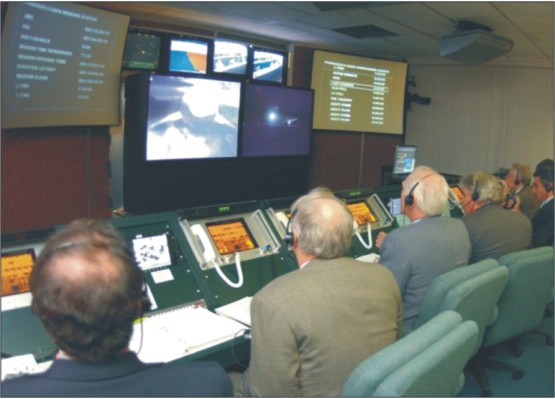Satellites are the eyes and ears of any national aerospace command, but sadly India has not yet deployed an independent dedicated satellite for its armed forces.
Since space has now become the fourth dimension of modern-day combat, powerful nations have already set up an aerospace command, but Indian defense bosses are still mulling over the decade old proposal. The armed forces have been clamoring for such aerospace command, but the government has only taken minor steps in this direction when the setting up of an Integrated Space Cell was announced by the defence minister A K Antony in Indian Parliament in December, 2011 for acquiring space capabilities.
He had also informed then that the satellite requirements of the armed forces are being met from the existing facilities. Steps have also been taken for provision of dedicated satellite facilities for the armed forces. Antony also informed that the integrated space cell was constituted in August, 2009 under Headquarter Defence Staff which has been tasked to coordinate the acquisition of requisite space based facilities.
He had also claimed that government has mechanism in place to effectively exploit space resources for the defence and security of the nation.
Self-dependence
After an independent satellite for Navy gets operational, the surveillance capability and network centricity for the Indian armed forces will greatly improve with the launch of first of seven Indian Regional Navigation Satellite System (IRNSS) GPS navigation satellites into orbit coming June.
This system will provide real time position, navigation and time services to multiple users which include military also. The constellation of seven satellites, to be placed in various orbits by 2015, will provide two basic services standard positioning service for civilian users (which will use the CA code) and restricted precision encrypted navigation service ( Py code) for authorized (i.e. military) users.
Thus in coming years this will obviate the need for dependence on the American GPS which is controlled by the US military hence prone to disruption during military standoff.
Though India will also get the encrypted navigation signals from the Russian Glonass for military purposes, the IRNSS will lay the foundation for an indigenous space based Global Positioning System, which can be strengthened in the years to come.
This entire infrastructure being put in space by ISRO will definitely augment the capabilities of the future Indian Aerospace Command. Even if the actual setting up of this command in real sense is delayed, the Indian armed forces can avail many of the services which will be made available by the ISRO.
The Indian Air Force was the first to propose the establishment of such a command and has already come out with a Defence Space Vision 2020 which has outlined the need to harness satellite resources in a big way to augment Indian defence alertness.
According to the vision 2020 IAF has identified the outer space as an area of intense focus to sustain India’s strategic lead and be ready to challenge any surprise attack from space. The IAF had strongly recommended the case of setting up a tri-service aerospace command in order to exploit the “final frontiers” and sharpen the combat edge of the country’s armed forces.
This tri-service aerospace command has been proposed to be on the lines of Strategic Forces Command, which controls India’s nuclear resources.
Considering the vastness of the infrastructure required and likely huge expenses for an aerospace command, Indian defence establishment is perhaps moving at a snail’s pace.
But the kind of security challenges that are emerging from India’s neighborhood, its urgency can be well understood. The kind of threats the country will be facing will emerge mainly from ballistic missiles, loaded with nuclear explosives and Indian armed forces need to be on constant alert, especially during war time, as other so called friendly country may not eagerly assist India in defending Indian skies, through their space assets.
Obtaining real time situational awareness of the adversary land and maritime area will be the prime objective of the Aerospace Command. Since the Indian defence establishment is also on the route to acquire the Ballistic Missile Defence System, they must be aided by a dedicated military surveillance satellite to enable the Missile Defence Systems to be prompt in countering the threat.
Though the Indian Space Research Organisation has already developed the GSAT-7 satellite for Indian Navy to be launched from French Aerospace giant through its ARIANE rocket, the delay is mysterious. Though the ISRO has not officially described the GSAT-7 as a satellite for military purposes, it is known as such and the French space authorities have not yet given the final launch date.
But the Indian Navy is eagerly waiting for a satellite to be launched exclusively for it , though Indian Army and Air Force would also be using this. There is a separate plan of dedicated satellites for the Indian Air Force and the Indian Army, but till the time they are launched both the armed forces would be using the GSAT-7.
Satellite network
The GSAT-7 would be networking all the Indian warships, roaming in the high seas, from the Eastern African coast to Strait of Malacca. Considering the regular forays of the Chinese warships in the Indian Ocean and their visits to the Indian neighboring countries, Indian navy must have situational awareness of not only its own warships, but also keep a regular watch over others, in view of the heavy, force deployment in the maritime area.
Since the Chinese are expanding their military presence in the Indian Ocean by making serious efforts to acquire rest and recreation facilities on the island nations and developing port infrastructure in the neighboring countries, India must maintain a close surveillance infrastructure in the space.
As a first real step in deploying requisite facilities in space, the Indian Space Research Organisation had booked a berth in the ARIANE-5 rocket of the French Arianspace and had allocated Rs 448 crores for the payment of launch charges in the previous year’s budget for the Space Department.
The GSAT-7 is a multiband satellite carrying payloads in high frequency S-band, C-band and Ku- band. The satellite will link all the warships and submarines of the Indian Navy which will push the navy towards network centric operations. The GSAT-7 employs standard 2.5 tonne platform with a power handling capability of around 2000 watt and a lift-off mass of 2550 kg.
Indian defence establishment seriously started moving towards an aerospace command after the 2007 anti-satellite weapon test by China, but six years after, lack of dedicated satellite is a big concern for Indian strategic observers.
Though some of the transponders of civilian satellites have been made available to the Indian military, only a network of dedicated satellites would sustain the demand for a network centric command and control to defend the nation’s frontiers. The challenging need of the hour is to integrate India’s military infrastructure in a seamless fashion to be ready to face a war with command and control from the sky.
Besides, taking care of the military communication and surveillance needs of the Indian armed forces, the Indian aerospace command is also expected to look after the civilian satellites in space, which are now the life line of the nation. Any successful attempt by the adversaries to knock out any of the communication satellites will result in nationwide disruption of many essential services and thus can cripple the economy in single blow.
Since India is now very much dependent on space infrastructure, the defence establishment must be entrusted with the resources to safeguard all the space assets and also be able to hit the adversary as a second strike capability. Though Indian space technology is considered to be advanced enough to protect own space assets and simultaneously be able to hit at the adversary, funding seems to be principal constraint.
Considering the critical dependence of the nation on space, the government will have to fast forward the program to set up an aerospace command, besides augmenting the civilian space infrastructure at the ground, so that in case of any Indian satellite being destroyed the Indian Space Research Organisation is able to replace the satellite within a day or two.





